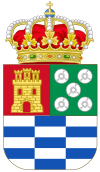Molina de Segura
| Molina de Segura | ||
|---|---|---|
|
||
| Location in Spain. | ||
| Coordinates: 38°03′N 1°13′W / 38.050°N 1.217°W | ||
| Country | Spain | |
| A. community | Murcia | |
| Province | Murcia | |
| Comarca | Vega Media del Segura | |
| Municipality | Molina de Segura | |
| Government | ||
| • Mayor | Esther Clavero Mira | |
| Area | ||
| • Total | 169 km2 (65 sq mi) | |
| Elevation | 125 m (410 ft) | |
| Population (2015) | ||
| • Total | 69,331 | |
| • Density | 410/km2 (1,100/sq mi) | |
| Website | www.molinadesegura.es | |
Molina de Segura is a municipality of Spain in the autonomous community and province of Murcia. It is located 10 km from the provincial capital, Murcia.
The town has a line of walls dating to the Almohad era (11th-13th centuries).
The town of Molina de Segura is located in Europe, in the east of the Iberian Peninsula, belonging to the kingdom of Spain, and part of the Region of Murcia. The township has an area of 169 km2 with flora and fauna belonging to the very dry Mediterranean climate (340 mm of rainfall per year) to which it belongs. It borders the towns of Las Torres de Cotillas, Alguazas, Lorquí, Ulea, Archena, Abarán, Blanca, Murcia and Fortuna. It has the fourth largest population in the region after Murcia, Cartagena and Lorca, with over 60,000 inhabitants. It is located 10 km north of the capital. Through it passes the N-301 highway that runs from Madrid to Cartagena. From Murcia Molina de Segura can be reached by two motorways, one direct and one urban population that surrounds and connects the Mediterranean motorway. It has a train to Madrid, from next Alguazas. The airports of Alicante and San Javier and the seaport of Cartagena are located half an hour away by car.
The three major districts, La Ribera de Molina, Torrealta and El Llano de Molina, all exceed one thousand inhabitants and are the important Orchard Molina, tracing its emergence in the Arab stage, with the government of Murcia by Ibn Mardanis, 12th century. There is a long tradition of huerta, roughly translated kitchen gardens, in the region that are grouped into the inherited irrigation. They water the garden and Subirana Mayor ditches. Its main products are the peach, apricot and vegetables, and its famous tomatoes, onions and peppers.
The smaller hamlets, Fenazar, Valientes (The brave), Campotéjar Alta, Campotéjar Baja, Comala, La Espada (The Sword), Rellano (Landing), Albarda, La hornera and Romeral are on dry land with little production of cereals, olives and sheep. Esparto predominates, thyme and rosemary. They are the Sierra de la Espada, the Place and La Pila. In the Campotéjar, in recent years there have been significant changes rainfed to irrigated with the water supply of the Tajo-Segura, highlighting Campotéjar Irrigation Community. Its main crops are fruit trees of high quality, whose destinations are the European markets.
...
Wikipedia


